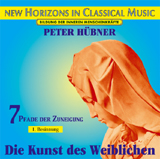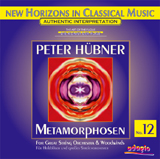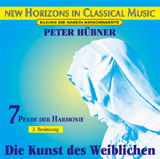|
THE COMPOSER ON HIS HYMNS & SYMPHONIES OF THE PLANETS |
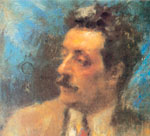 Puccini “The great secret of all creative geniuses is that they possess that power to appropriate the beauty, the wealth, the grandeur, and the sublimity contained within their own souls, which are part of Omnipotence, and to commu-nicate those riches to others. The conscious, purposeful appropriation of one’s own soul forces is the supreme secret I first grasp the full power of the EGO within me. Then I feel the burning desire and the intense resolve to create something worthwhile. This desire, this longing, implies in itself the knowledge that I can attain my goal. Then I make a fervent demand for and from the Power that created me. This demand, or prayer, must be coupled with full expectation that this higher aid will be granted me. This perfect faith opens the way for vibration to pass from the dynamo, which the soul-center is, into my consciousness, and the inspired ideas are born. We mortals here on this earth are partners of the Creator but few there be who realize it. It is the same with a composer. He must acquire by laborious study and application the technical mastery of his craft; but he will never write anything of lasting value unless he has Divine aid also. There is a vast amount of good music paper wasted by composers who don’t know this great truth. We are dealing in this domain with higher spiritual laws. Dante, Rafael, Stradivarius all drew on that same Omnipotent Power. The inspiration from above stimulates the intellect and the emotions An inspired person sees things in a totally different light from one who is not inspired. Inspiration is an awakening, a quickening of all of man’s faculties, and it is manifested in all high artistic achievements. It is an overwhelming, a compelling force. In short, it is a Divine influence. I cannot do better than quote to you what I said to my friend, Pietro Mascagni, after I had finished the score of Madam Butterfly last October: The music of this opera was dictated to me by God; I was merely instrumental in putting it on paper and communicating it to the public.” Puccini
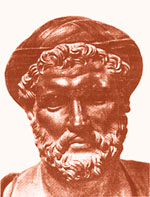 Pythagoras Pythagoras, who until today is considered the founder of our scientific age by the great thinkers, has established in his very profound examinations that the same laws of harmony that determine the inner tonal developments in the Microcosm of Music also dominate the biological organisms within evolution, and beyond that direct the processes in the entire cosmos.
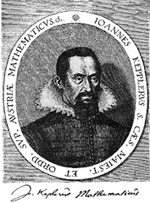 Kepler The famous musicologist and astronomer Johannes Kepler also reaffirmed that the paths of the stars follow the same laws of harmony as the inner sound paths or developments in the microcosm of music. Indeed, Kepler even originally calculated the planetary orbits on the basis of his music theoretical findings. |
||||||||
CLASSIC-Life: Herr Hübner, how can the confusing sound structures of the “Symphonies
of the Planets” or the “Hymns of the Planets” be grasped? The tonal structure is confusing, but at the same time, a compositional logic is hardly recognisable. PETER HÜBNER: I’m pleased to hear that, and at the same time I’m surprised. I must tell you: all the symphonies and hymns of “the Planets” are related to each other and refer to each other – not less than in the “Art of the Feminine” and the “Metamorphoses”, as well as the “Sun”, “Moon” and “Star Symphony”. What is confusing, is the distraction of one’s attention from the inner logic and harmony of the composition by the sound. I’ll explain that: When you see a person – do you also see his soul? At one time, you see him in certain clothes doing this kind of work, then you see him in completely different clothes doing some totally different work. And you do not doubt that during all these diverse forms of appearance he always has the same soul – even if you don’t see it. There are people who claim that another person’s soul is not concealed to them – they can perceive it, and they know that the soul does not age, and that it is not subject to the same changes as the body with its clothes and various actions. These people also claim the soul is covered by the mind and thinking, and the jumble of thoughts as well as the body – as if by a large pile of rubbish against which the soul continuously has to hold its own ground. In the area of health, the growth and regeneration processes are perhaps the natural expression of the fact that the soul asserts itself in the body. In the social field, there are perhaps mental explosions, outbursts and release of rage, and finally also one’s health as well as a harmonious, orderly attitude towards one’s fellow men, which bear witness to the success of the soul in humans. I show this liberation of the soul at the very beginning of my musical epos “Song of Life” in the scaffolding scene, where the man-made world scaffolding collapses under the influence of the cosmic breath and/or the cosmic winds, and is blown away, and then the tree of life: the soul becomes visible – which previously had been hidden and/or covered by that man-made scaffolding, by mental and physical stress. The “Symphonies of the Planets” characterise all this, but their focus lies in the regeneration processes and/or the release, and in the hidden harmony and order as well as the harmony and order which is meanwhile less concealed. But as chaotic this release might seem here and there, it is equally controlled by inner harmony as, for instance, the 5 voices in the series “The Art of the Feminine” by the basso continuo. In the “Symphonies of the Planets” the matter stands roughly as in the series “Love” in the “Art of the Feminine”. We clearly experience the regeneration processes, the release. But the basis for these development processes remains more or less obscure to us: harmony – in a human area: the soul. In the “Hymns of the Planets” the soul and/or the harmony of the soul is more or less clearly represented by the voices of the chorus and soloists, whilst the orchestra simultaneously performs the mental and physical cleaning processes and the release which are linked to them. Thus, in the hymns we have in comparison in the voices the basso continuo of the whole, which gives the entire, more or less raging orchestra, its inner peace – if not even “stillness”. If, as a listener, you turn your attention in “Hymns of the Planets” mainly to these singing voices, and the chorus, you experience the stillness of cosmic development in the microcosm of music, and if you let yourself be more distracted by the orchestra – you then, comparatively, quite frequently plunge into chaos. But that’s how it is in life anyway: if you concentrate more on the nature of things, harmony and stillness enter your consciousness. And if you turn your attention mainly to the variable, often confusing externals of life whose changes are fundamentally guided out of the harmonious stillness and are kept together by it, then the order of thinking can easily be turned completely upside down, and confusion takes control. In order to prevent any misunderstandings: the “Symphonies of the Planets” contain the harmonious stillness just as the “Hymns of the Planets” do – but you have to look harder for it and listen more closely to localise it more and more. In the Hymns this search is facilitated by the solo voices and the chorus. Listening to the “Symphonies of the Planets” is therefore good practice for looking behind the scenes of such a seemingly chaotic and/or inscrutable, incomprehensible world, and for concentrating on the essential which holds everything else together. Kepler proved that the course of the planets follow the same laws of harmony as we find them in the microcosm of music. Indeed, he even derived his planetary laws from the laws of tonal development of the microcosm of music. His outstanding astronomical findings were thus the result of musicological investigations into the microcosm of music. He also confirmed the statement made by Pythagoras that the laws of harmony of the microcosm of music and the entire cosmos are identical. Socrates extended this statement to the soul. It must be taken for granted that the “Symphonies” and “Hymns of the Planets” were created according to exactly these laws of harmony of the microcosm of music – this is my speciality. |
|||||||||
